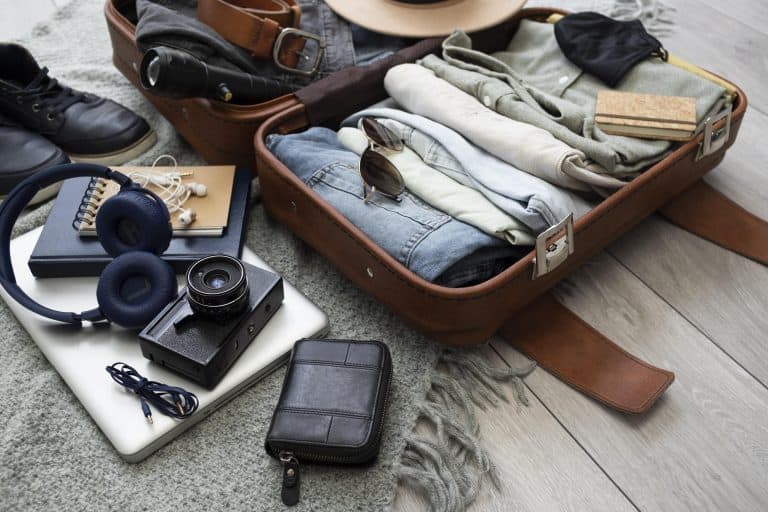Can I Bring a Heating Pad on a Plane? Yes! TSA and Custom Rules

Packing for a trip always brings up unexpected questions—especially about comfort items that straddle the line between personal care and medical tools. If you’ve ever relied on a heating pad for sore muscles, back pain, or just to stay cozy in chilly cabins, you may be asking: Can I bring a heating pad on a plane?
The answer is yes—but with a few caveats.
In this guide, I’ll walk you through TSA rules, customs guidelines, and smart packing tips for heating pads of all kinds—electric, battery-powered, gel-based, and microwaveable. Whether you pack it for comfort or pain relief, knowing what’s allowed (and how to pack it) will help you avoid delays at security and customs.
Related guides you may find helpful:
Flying with Toiletries
Flying with Grooming Tools
1. Understanding TSA Guidelines for Heating Pads
When packing for a flight, many travelers wonder whether they can bring heating pads to help relieve pain or stay warm during long journeys. The good news is that TSA guidelines for heating pads are clear.
1.1 Are Heating Pads Allowed in Carry-On Bags?
Heating pads are welcome in your carry-on luggage, but with a few important considerations. TSA does not ban them, and they don’t fall under the same restrictions as medications or oxygen tanks. Still, the type of heating pad you bring and how you pack it can influence your experience at the airport. Here’s what you need to know:
- Electric heating pads with cords are permitted, though TSA may ask you to remove them from your bag during screening for a closer look.
- Battery-powered heating pads are also allowed, but the batteries must meet TSA battery guidelines. Lithium-ion batteries must be carried in your carry-on bag and cannot exceed 100 watt-hours (Wh) for individual batteries. Learn more about bringing lithium batteries on an airplane.
- Microwavable heating pads filled with grains, like rice or flaxseed, are allowed, but TSA agents may inspect them for organic material.
KEEN TIP: Always pack heating pads in an easily accessible area of your carry-on to make TSA inspections faster. If your pad has batteries, ensure they are installed or stored properly to avoid delays.
1.2 Can You Pack a Heating Pad in Checked Luggage?
You can absolutely put a heating pad in your checked bag, but it’s not quite as simple as tossing it in.
- For electric models, take extra care to cushion the heating elements and prevent damage to the cord. A burst suitcase or rough handling could break the wiring and make your pad unusable when you arrive.
- Battery-powered pads, while convenient, must follow battery safety rules. Airlines typically prohibit lithium-ion batteries in checked bags because of fire risk. If your pad has a removable battery, take it out and pack it in your carry-on.
- Microwavable heating pads are generally safe to check, but be mindful of rules on bringing organic materials into other countries. Customs agents may treat them differently, especially if they resemble food or agricultural products.

2. International Travel Rules for Heating Pads
Flying internationally with a heating pad requires additional steps to comply with customs regulations and foreign security requirements. Rules may vary by country, so understanding the differences between TSA and international customs is essential.
2.1 Key Differences From TSA Guidelines
- When flying out of or into another country, you’ll be subject to that country’s customs and security laws. This is where things can get tricky. For example, while TSA allows microwavable pads with organic contents, some countries—particularly Australia and New Zealand—have strict biosecurity laws. They may classify microwavable heating pads with grains or seeds as agricultural products, which could trigger quarantine inspections.
- Electrical voltage differences overseas may render U.S.-based heating pads incompatible unless you bring a voltage converter.
KEEN TIP: Research the customs policies of your destination country well in advance to avoid confiscations or delays. Label your checked luggage clearly if it contains electrical devices to prevent delays during inspections by TSA or international customs agents.
2.2 Declaring Heating Pads at Customs
If you’re unsure whether your heating pad will raise concerns, declare it. Customs officials are more forgiving when travelers are upfront. You might be asked about the contents of a microwaveable pad, or asked to show documentation for a battery-powered device.
Carrying the original product packaging, a receipt, or even a quick-start guide can help clarify its purpose and avoid suspicion. Remember, customs officials are trained to look for anything unusual—so err on the side of caution.
KEEN TIP: Bring the receipt and manufacturer’s information for your heating pad in case customs officials need verification of its purpose.
3. Choosing the Right Heating Pad for Travel
3.1 Electric Heating Pads
Electric heating pads are a common choice for home use, but they aren’t always ideal for travel. If you’re flying internationally, voltage incompatibility can be a real issue.

Voltage differences: Many countries use 220-240V instead of the 110V used in the U.S. You’ll need a voltage converter if your pad doesn’t support dual voltage.
Plug adapters: Bring a universal plug adapter to match outlet shapes overseas.
Battery-powered models: These are more flexible but must follow TSA battery rules for lithium-ion batteries in carry-ons.
Cord storage: Protect the wiring from damage by securing cords and using padded cases.
3.2 Microwaveable Heating Pads
No cords or batteries: These pads heat up in a microwave, so you don’t need to worry about outlets or adapters.
Organic materials: Be cautious if they contain grains or herbs, as some countries’ customs rules may classify them as agricultural items subject to inspection.
Microwave access: Ensure your destination has microwave facilities if you plan to use this type.
Durability: These pads are generally more compact and lightweight, making them easier to pack.
KEEN TIP: To avoid delays or confiscation, keep these pads in their original packaging and declare them when required.
3.3 Battery-Powered Heating Pads
- Travel Friendly: Most models are powered by rechargeable lithium-ion batteries. As long as the battery doesn’t exceed 100Wh, it’s allowed in your carry-on.
- Extra Batteries or Portable Charger: These pads are especially useful if you’ll be in transit for a while and need relief without hunting for an outlet. Just remember to fully charge the battery before your flight and carry extra batteries or a power bank if you plan to use it on a long-haul journey.
4. Packing Tips for Heating Pads
4.1 Protecting Electric Heating Pads
The internal components of electric heating pads are sensitive to pressure and moisture.
- To avoid damage, place the pad in a soft case or wrap it in a scarf or sweater.
- Tuck the cord in a separate section of your bag or secure it with Velcro straps or zip ties to keep it from tangling.
- If your bag is full, don’t jam the pad at the bottom—pack it where it won’t be crushed.
KEEN TIP: Use Velcro straps or zip ties to organize cords neatly and prevent them from shifting in your bag.
4.2 Storing Gel or Liquid-Filled Heating Pads
These pads aren’t common, but if you use one, pack it like you would a toiletry.
- Pack gel-filled pads in waterproof bags to prevent leaks.
- A clear plastic bag means faster inspection at TSA checkpoints.
- Store liquid-filled heating pads upright to minimize leakage risks.
KEEN TIP: Bringing a small towel or absorbent cloth is also a good idea—especially for long flights where pressure changes may cause slight leaks.
5. Using Heating Pads During the Flight
5.1 Can You Use a Heating Pad on the Plane?
You can, but you need to plan ahead.

- Electric heating pads must be plugged into power outlets or can be charged by a portable power bank.
- Cordless models offer the most flexibility and can typically be used in-flight as long as they meet airline battery policies.
- Microwaveable pads won’t help mid-flight since there’s no way to heat them.
5.2 Battery Safety Guidelines
As with any battery-powered item, be cautious about safety. Make sure batteries are stored properly, spares are in protective cases, and heating pads are never left unattended.
KEEN TIP: Carry extra batteries or power banks in case your flight is delayed or longer than expected.
6. Security and Customs Troubleshooting
6.1 At TSA Checkpoints
If TSA agents pull your bag aside, don’t panic. They may just want to verify that your heating pad is what you say it is. Calmly explain its use and, if necessary, show them how it works. Most travelers report no issues, especially when carrying documentation or original packaging.
6.2 At International Customs
Outside the U.S., inspection procedures vary. Some countries take agricultural items seriously—so a microwavable pad filled with grains might need to be declared or inspected. Battery-powered devices can also be flagged.
KEEN TIP: Be prepared to demonstrate how the pad works if requested. Having your receipt or a product brochure on hand will speed things along.
7. Frequently Asked Questions (FAQ’s)
7.1 Can you bring a cordless heating pad on a plane?
Yes, as long as the battery is under 100Wh and packed in your carry-on.
7.2 Are there size limits for heating pads in carry-on bags?
TSA does not impose specific size limits for heating pads, but they must fit comfortably in your carry-on bag and comply with airline size restrictions for carry-on luggage.
7.3 Do you need to remove a heating pad during TSA screening?
Possibly. TSA agents may request you to remove the heating pad for separate screening, especially if it has wires, batteries or electrical components.
7.4 Can you bring USB-powered heating pads on international flights?
Yes, but check voltage compatibility and local customs rules.
7.5 How do you declare a heating pad at customs?
Declare heating pads at customs if they contain organic materials like grains or herbs, or if they have battery-powered components. Provide receipts and manufacturer details if questioned.
7.6 Are there restrictions for microwavable heating pads with grains?
Yes, microwavable heating pads filled with grains or seeds may face agricultural restrictions in some countries. Check customs rules beforehand and consider using a gel-based pad instead.
7.7 Should you pack adapters for heating pads on international trips?
Absolutely. If using an electric pad abroad, bring a universal plug adapter and voltage converter if needed.
8. Wrap Up
Bringing a heating pad on a plane is completely doable with the right prep. Most pads—whether electric, cordless, gel-filled, or microwaveable—are TSA-compliant when packed correctly. International travel adds a few layers of complexity, especially when customs or voltage compatibility come into play.
If you plan ahead, pack smartly, and double-check the rules of your destination, your heating pad can provide welcome relief and comfort during travel. Don’t forget your adapter—and maybe a little pouch to keep it all neat and tidy!






